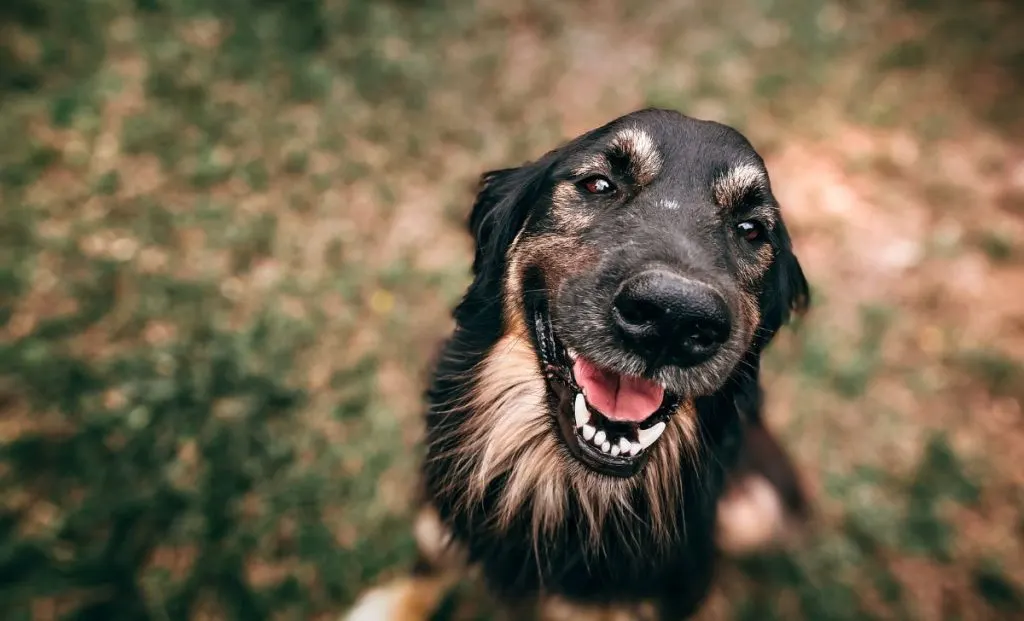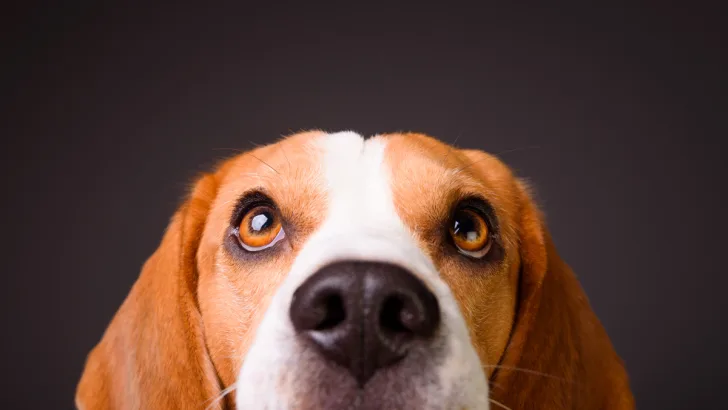I am guilty of buying colorful sweaters and countless toys in every color possible for my dogs. If you are like me, you have probably asked yourself what colors do dogs see while standing in a pet shop browsing for a new toy to bring home.
Would the blue toy or the orange toy be a better pick for dog eyes? You may have heard that pups are color-blind or, even worse, that they see the world in black and white. The reality of this topic is a little more complex than that.
Our furry babies can see color but have a more limited color vision spectrum than us. All those bright colors on various toys and bedding are pretty muted to dog eyes.
So that leaves us with the initial question – what colors do our canine companions see? The answer about your pup’s vision might surprise you but also give you a greater appreciation for how dogs navigate the world.
Human Eyes VS Dog Eyes

Our race evolved to have the best vision for the world we had to survive in. As we all know, humans are primates, and the primates we come from did most of the foraging in the daylight. (1)
Those primates also ate a varied diet, but for the most part, it was thought to be fruits and berries. They needed to recognize when the food was ripe, so color vision, especially red vs green color vision, was crucial.
We have kept the trait even today, allowing us to see the full spectrum of the color wheel and color perception.
Detailed vision and depth perception, which help in hand-eye coordination, were crucial to picking berries effectively and making tools later on, which makes sense from the evolutionary perspective.
However, the ancestors of our pups did most of the hunting in the dim light, like at night, dusk, or dawn. Their main focus was hunting, so if something was green or red, it made no difference in the result for them.
The main focus was the prey´s small movements, and their eyes are still adjusted to that today.
How Does Light Pass Through
To completely understand why dog eyes and human eyes are different, you must understand how the eye works. The light enters the eye through the clear cornea. That is the eye’s front surface.
The larger the cornea is, the more light can go through it. If you compare us with our dogs, you will see that the human cornea is noticeably smaller. What does that mean? The human cornea can’t gather light as well as a dog’s cornea.
After the light passes the cornea, it passes the iris (the colored layer of the eye). At the center of the iris, we can notice the pupil. The function of it is to open and close to allow in more or less light.
If you are in the dark, the iris opens as wide as it can, and if you look at the bright sun, it will clamp down to a small diameter.
Sit in a dark room with your pup for about 10 to 15 minutes and turn on the lights, or even better, take a flash picture in the dark; you will notice the pupil of your pup can get much, much larger than yours.
This means the eyes of your pup are designed to allow more light to get in while it’s dark. But there is a trade-off in this – when the pupil is open wide, it makes focusing on anything but a small range awfully difficult.
Different Types Of Cones Found In Eyes
Eyes have two main kinds of photoreceptors: the rods and the cones. Rodes contain chemicals that are extremely sensitive to all wavelengths of light.
The rods are the ones important for vision in dim light, and the cones are essential for vision in radiant light as well as color vision.
The cones, on the other hand, contain one of two or even three different chemicals that are amazingly sensitive, but only to certain wavelengths of light. Our pups have many more rods than we humans but far fewer cones.
Our race has three different cone types, each sensitive to different wavelengths, while dogs have only two cone types.
Both the cones and rods are connected to “ganglion cells.” They transmit information from the photoreceptors to the brain, which then combines the impulses from the photoreceptors.
In the periphery of the eye, as many as 1000 rods will be connected to one ganglion cell, further enabling slight amounts of light to be detected. However, this is at the expense of detailed vision.
Closer to the center of the eye, as few as five cones might be connected to one ganglion cell, enabling fine detail vision but at the expense of dim light vision.
This is why you can better notice dim stars in the periphery of your vision (using rods) than when you’re attempting to look straight at a dim star (using cones).
So What Colors Attract Dogs The Most

Scientists once thought dogs only saw the world in back and white.
The idea took off in the general public imagination as a popular myth in the 1940s when an optometrist named Gordon Walls published his influential book, in which he claimed that dogs could only weakly see color, if at all. (2)
This myth was finally debunked in 1989 when ophthalmologist Jay Neitz, then at the University of California, and his colleagues discovered that canines could see dark blue and blue colors as well as warm yellows but not reds and greens. (3)
Even some humans, about eight percent of men and 0.5 percent of women, are similarly red-green color-blind. (4)
“Our work has had a big influence, and lots of people now understand what color vision in dogs really is,” says Neitz, who is now an ophthalmology professor at the University of Washington.
But to really understand how dogs see the world, we need to move beyond color, says Sarah-Elizabeth Byosiere, an animal behaviorist and former director of the Thinking Dog Center at Hunter College.
While a green or red ball lying on grass would not stand out easily to your pet, it might challenge them to identify it by its other features—such as its movement, shape, and the way it reflects light, Byosiere says.
That challenge could either be enriching or frustrating. “It all depends on an individual dog’s behavior,” she says.
Dog Vision
If you’re really trying to imagine the world through the eyes of your dog, you should picture everything a lot blurrier.
Most dogs have 20/75 vision (5), (it was a topic of research) meaning that they must be 20 feet away from an object to see it, as well as a human with clear vision who is standing 75 feet away.
They even have a unique structure in their eyes called the tapetum lucidum, a mirror-like membrane that allows them to see in six times less light than humans can.
The tapetum, which some other animals, such as cats and cattle, also possess, sits behind the retina and reflects light back onto it, giving the receptors a second chance to gather more visual detail.
It’s also the reason your pet’s eyes glow in photos (while we have red eyes in flash photography) and in the dark.
Also crucial for dogs’ perception is their sense of smell, which is 10,000 to 100,000 (6) times more powerful than an average human. This is as true for chihuahuas and pugs as it is for bloodhounds.
While humans have about five million smell receptors, dogs possess up to a billion and can communicate with one another with chemical signals. That is one of the reasons why dogs sniff butts. They can pick up scents as far as 12 miles away.
And canines’ mighty sense of smell is inextricably linked to how they see the world. A study published last year in the Journal of Neuroscience revealed that the canine’s brain has a direct connection (7) between its olfactory bulb, which processes smell, and its occipital lobe, which processes vision.
The authors stated that this integration of sight and smell had not been observed before in any animal species.
Miller says the results raise the question of whether dogs’ sense of smell is orienting their sight. “It’s pretty wild,” adds Miller, who was not involved in the study. “They [may be able to] smell in 3-D.”
What Color Toys To Buy For Your Best Friend

When it comes to buying toys for our canine companions and best friends, we don’t always have to select the two only colors they can see: yellow and blue.
Byosiere recommends getting one red and one blue toy to enrich your pet’s play.
You may want to throw the red one on the green grass or your green lawn so that your pup uses its nose and then throw a blue one so that it uses its eyes.
“These animals are not deprived in any way,” Byosiere says. “It’s just that they just see the world in a different way.”
References
1. McKinley, June. “What Do Primates Have in Common? Humans & Our Cousins | AMNH.” American Museum of Natural History, The American Museum of Natural History, 23 Mar. 2020, www.amnh.org/exhibitions/permanent/human-origins/understanding-our-past/living-primates. Accessed 1 Apr. 2024.
2. ROAF, H. E. “The Vertebrate Eye and Its Adaptive Radiation.” Nature, vol. 151, no. 3826, Feb. 1943, pp. 236–236, https://doi.org/10.1038/151236a0. Accessed 1 Apr. 2024.
3. Neitz, Jay, et al. “Color Vision in the Dog.” Visual Neuroscience, vol. 3, no. 2, Aug. 1989, pp. 119–125, https://doi.org/10.1017/s0952523800004430.
4. Chia, Audrey & Gazzard, Gus & Tong, Louis & Zhang, Xiaoe & Sim, Ee-Ling & Fong, Allan & Saw, Seang-Mei. (2008). Red-green color blindness in Singaporean children. Clinical & experimental ophthalmology. 36. 464-7. 10.1111/j.1442-9071.2008.01799.x.
5. Recognized Veterinary Specialty Organization® of the AVMA. “Vision in Pets.” ACVO Public, 23 June 2022, www.acvo.org/tips-treatments-tricks/vision-in-pets. Accessed 1 Apr. 2024.
6. Walker D, Walker J, Cavnar P, Taylor J, Pickel D, Hall S, et al. Naturalistic quantification of canine olfactory sensitivity. Appl Anim Behav Sci (2006) 97:241–54. doi:10.1016/j.applanim.2005.07.009
7. Andrews, Erica F., et al. “Extensive Connections of the Canine Olfactory Pathway Revealed by Tractography and Dissection.” Journal of Neuroscience, vol. 42, no. 33, 17 Aug. 2022, pp. 6392–6407, www.jneurosci.org/content/42/33/6392, https://doi.org/10.1523/JNEUROSCI.2355-21.2022. Accessed 1 Apr. 2024.

Nandina has been a lifelong dog owner and enthusiast. She shared her home with multiple breeds, including Giant Schnauzers, Cane Corsos, and Huskies. Currently, she is raising a three-year-old rescue and a working-line German Shepherd puppy.
Actively engaged in IGP dog sports for two years, Nandina is a certified instructor for basic obedience and socialization. She works as a trainer in her local dog sports club, and in her spare time, she handicrafts biothane gear for dogs.
